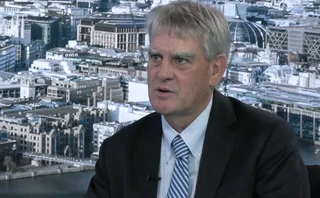
Equity derivatives house of the year: Citi
Risk Awards 2021: US bank vaults into the top-tier, with some help from Garry Kasparov

The dizzying stock market selloff and rebound in the first half of 2020 made risk systems go haywire and sank some of the world’s largest volatility hedge funds. But quick reactions – and an unlikely partnership with chess grandmaster Garry Kasparov – allowed Citi to avoid major losses and continue its charge up the rankings.
At $32 billion, the bank’s equity structured note issuance jumped 80% in 2020, catapulting it into the top three in the US market. In exotics, Citi topped Coalition’s rankings in the first half of the year.
Clients were impressed – and even a little taken aback – by the bank’s performance. “This year, they’ve been surprising,” says an investment officer at a pension fund, which has increased the amount of equity derivatives trading it does with Citi by fivefold in the past two years. “In terms of the right pricing and the platform, they’re there.”
Perhaps the only ones not surprised were those in the business. Citi’s breakthrough in equity derivatives has been four years in the making. Or as David Haldane, global head of derivatives trading, puts it: “It’s not like we’ve suddenly got a number one pop song and just appeared on the scene. We’ve been touring around shady pubs for a while to build into this and now we’re making an appearance on a global stage.”
Along the way, the bank upgraded its structuring capabilities and went on a hiring spree that brought in top talent from tier one rivals and re-invigorated its exotics and quantitative investment strategies (QIS) businesses. One asset manager describes Citi’s thought leadership in these areas as “second-to-none”.
A laser focus on risk management underpins everything. When the first cases of Covid-19 were detected in Europe in late February, the business moved quickly to stress test counterparty relationships against potential disaster scenarios. With ears to the ground and data on thousands of client positions to hand, they identified a “handful” of counterparties that might struggle to meet margin calls and began talking to them about restructuring or unwinding positions.
In one instance, Citi unwound a series of trades at a small loss. Rival banks lost hundreds of millions of dollars when the counterparty eventually toppled into default.
“Rather than running it to the last mile and leaving it to a scenario where all dealers are trying to unwind what’s likely to be the same risk against these clients, we thought we would be best to work with them very closely. While it was difficult and painful for both the client and us leading up to those events, we feel it was ultimately the right call to make,” says Quentin Andre, Citi’s global head of derivatives sales.
The danger list was short. The bank typically trades large hedges and risk recycling packages with counterparties that can weather mark-to-market storms.
“On our convexity hedges for the broader business we always look to face a pension fund or somebody that had a very large amount of AUM that we weren’t going to struggle with,” says Haldane. “If you’re going to buy convexity from somebody, you may not want to buy it from a $100 million hedge fund because the products you trade in, such as variance, can be very explosive as far as the payoff is concerned.”
At Citi, such blow-ups were few and far between in 2020.
Checkmate
The equity derivatives business also got some help from one of the greatest chess players in history.
The tie-up happened by chance. Since his 1997 defeat to IBM’s Deep Blue – the first time a reigning chess champion was beaten by a computer – Kasparov has lectured on decision making, algorithms and machine learning. After listening to him speak at a conference hosted by Citi in 2018, the equity derivatives team began talking to Kasparov about incorporating elements of his thinking into their investment process.
The result was a new spin on mean variance optimisation indexes. Based on Harry Markovitz’s half-century-old asset allocation theory, these indexes are widely used in retirement products. But many of them have struggled to perform against a backdrop of ultra-low rates, where bonds provide less of a hedge against equity corrections.
Citi’s Grandmaster index deals with this by emphasising the importance of recent market changes.
“Very successful investment models are based on prediction of the past, but because things are changing so fast and the number of factors we have to incorporate may accumulate so fast, these long-term histories might be counterproductive,” Kasparov says.
“The idea of the index was to make it more adaptive to immediate changes. It departs from the past in emphasising the importance of dynamic changes and gives more value to relatively new factors. It’s also built in a way that you can explain the concept, it’s not a black box, and the way it operates for investors is the same as if you had used a traditional approach.”

Traditional mean variance optimisation algorithms only think one step ahead, using today’s data to optimise short-term gains. Like an elite chess player, Citi’s next-gen mean variance index plans 12 steps ahead, playing out a huge number of market simulations. Machine learning techniques are used to analyse the impact of volatility on asset behaviour and identify a sequence of asset allocation decisions that are most likely to deliver the strongest risk-adjusted returns over time.
The index is also backed by more traditional academic research – Kwang Soo Cheong, professor of quantitative finance at Johns Hopkins University, was also involved in its creation. One US distributer describes it as “probably the best I’ve seen in a proposal in a long time”.
The index proved its worth in 2020’s real-world stress test. In February, it outperformed a traditional mean variance optimisation index by more than 7%, as early signs of market distress triggered a switch out of equity well ahead of peers.
In November, the bank signed an exclusive deal with a US distributer to sell fixed indexed annuities linked to the index.
Feel the force
In addition to next generation retail strategies, such as Grandmaster, Citi rolled out a new breed of execution-based products that broke the traditional QIS mould. Sitting firmly in this bucket, the bank delivered a first-of-its kind hedge for Italy’s Generali that unlocked capital set aside against €350 million of future profits at the insurer’s French unit-linked life insurance business. Industry-wide use of such hedges could release an estimated $12 billion of capital across the $3 trillion market unit-linked insurance products.
The unit-linked business is capital light, given policyholders bear the market risk. But Solvency II requires insurers to book the present value of future fees – the so-called value-in-force (VIF) – as an asset on the balance sheet. Capital must be held against swings in VIF. This can be highly volatile as VIF is linked to the net asset value of underlying portfolios and is ultimately driven by market moves.
Stabilising this fee stream and reducing the overall capital requirements of the unit-linked business had been a five-year ambition of Generali’s group chief financial officer, Christian Borean, and its capital management head, Eduardo Malpaga. Routes such as monetising future fee streams with reinsurers were expensive, leading Borean to seek a more cost-effective, transactional fix.
The structuring conundrum stumped several banks. Numerous proposals failed to fulfil the three-part brief of reducing P&L volatility, stabilising the balance sheet and lowering capital requirements. Most relied on put options, which Borean found to be prohibitively expensive.
“With the level of margins you have on unit-linked or mutual fund products you cannot afford to engage in expensive hedging structures,” he says.
In early 2019, Citi’s derivatives team came knocking with a delta-one proposal that struck a chord. A machine learning algorithm would replicate the performance of Generali’s unit-linked fund portfolios with a basket of equity and interest rate futures. The insurer could then short the index to hedge its VIF volatility and gain full capital relief on the free stream.
But there were other complications. To qualify for relief, hedges must be 90% correlated to the underlying exposures, while hedge accounting rules limited the types of structures Generali could use. Citi’s structuring team had their work cut out.
“It’s not like the usual type of hedging trade, where clients use derivatives payoffs solely to manage market stresses,” says Alexandre Isaaz, global head of equity and hybrids payoff structuring. “Here you have accounting and regulatory constraints, which were the most difficult part to take into account while designing the solution. This deal ended up being a real milestone trade for both the bank and the insurer, and was the result of a real partnership between the two firms.”
Citi remains tight lipped on the exact instrument used to short the index. But the replicating strategy turned out to be better than advertised, smashing through its 95% correlation target and realising at more than 99% – even through March.
“As a pure hedge it is a success,” says Generali’s Borean. “It helps us push for more and more because it’s a real balance sheet stabiliser.”
A 10-year hedge covering €3 billion of assets under management at Generali’s French unit-linked business was signed in December 2019. The structure is now being applied to additional portfolios and will be extended to the insurer’s Italian operations.
“I think this is the proof that we can turn a fee-based business such as the unit-linked one, into a service-based business,” says Borean “With ultra-low interest rates, everybody’s pushing for unit-linked products because they’re capital light, but there’s such a lack of capital in times of extreme volatility that everyone is trying to, and should, optimise. As soon as others see there is a good trade-off they should follow.”
Daily fix
Clients also welcomed Citi’s commitment to exotics through thick and thin.
At the peak of the crisis, the exotics desk had to juggle two distinct sets of demands. “On the one hand, clients who had established large relative value positions were looking for liquidity and ideas to help reduce exposures and unwind convexity in smart ways,” says Guillaume Flamarion, co-head of Citi’s multi-asset group in the Americas. “Lower velocity clients looked to leverage opportunities in various distressed pricing parameters across equities and hybrids. We established and unwound some large trades for clients in equity/rates pairs.”
One of the ways Citi helped clients to reduce exposures was with so-called impartial variance swap overlays. Volatility funds will often sell close-to-close variance swaps to fund the S&P 500 leg of relative value equity strategies, such as dispersion. By purchasing a vanilla close-to-close variance swap and selling an intraday version as an overlay, funds can kick their exposure off the close. This delivered up to 10 volatility points of positive performance during the sell-off, mitigating short volatility risk in clients’ books to the tune of hundreds of millions of dollars.
Another popular way of avoiding a congested close, where delta hedging activity tends to increase volatility, is with intraday momentum strategies. The big question is how to time the intraday fix. “If everyone moves away from the congested close and piles in at 12pm, you just transfer the problem,” says Flamarion.
That’s an acute concern for a bank that trades double-digit millions of vega notional on intraday overlays. Using cryptographic techniques, Citi designed a random function that generates a unique execution time for each client on a daily basis.
“Clients can get quite nervous about who knows what they’re doing and the footprint that’s left in the market. As well as being confidential and secure, the function is normally distributed, meaning over time, clients achieve every single tick in the day, ensuring they access the widest time range,” adds Flamarion.
A growing structured franchise is both a blessing and a curse. Unhedged front-year dividend exposures burned an €800 million hole in three French banks’ first half earnings – wiping out a chunk of equity trading revenues. Citi avoided most of the potholes, posting a 19% jump in equity trading revenues over the same period.
Those results were achieved without the foundation of a mighty flow franchise – a gap which is next on Citi’s to-do list.
“The experience we have in the solutions, corporate and structured business will be the stepping stone to deliver flow revenue and flow products to the rest of the client franchise,” says Fater Belbachir, who joined Citi in 2020 as head of equity trading.
Only users who have a paid subscription or are part of a corporate subscription are able to print or copy content.
To access these options, along with all other subscription benefits, please contact info@risk.net or view our subscription options here: http://subscriptions.risk.net/subscribe
You are currently unable to print this content. Please contact info@risk.net to find out more.
You are currently unable to copy this content. Please contact info@risk.net to find out more.
Copyright Infopro Digital Limited. All rights reserved.
As outlined in our terms and conditions, https://www.infopro-digital.com/terms-and-conditions/subscriptions/ (point 2.4), printing is limited to a single copy.
If you would like to purchase additional rights please email info@risk.net
Copyright Infopro Digital Limited. All rights reserved.
You may share this content using our article tools. As outlined in our terms and conditions, https://www.infopro-digital.com/terms-and-conditions/subscriptions/ (clause 2.4), an Authorised User may only make one copy of the materials for their own personal use. You must also comply with the restrictions in clause 2.5.
If you would like to purchase additional rights please email info@risk.net
More on Awards
Collateral management and optimisation product of the year: CloudMargin
Delivering the modern blueprint for enterprise collateral resilience
Flow market-maker of the year: Citadel Securities
Risk Awards 2026: No financing; no long-dated swaps? “No distractions,” says Esposito
Pricing and analytics: fixed income – Quantifi
Quantifi delivers high-performance, transparent and adaptable pricing and risk analytics for fixed income and credit markets
Derivatives house of the year: Citi
Risk Awards 2026: Rev up, RWAs down, as US bank gets back on track (with added XiNG and XiP)
Technology vendor of the year: SS&C Algorithmics
Risk Awards 2026: From cloud, to chips, to maths tricks – vendor getting more out of existing tech
SS&C Algorithmics: winner’s interview with Curt Burmeister
SS&C Algorithmics wins three categories in this year’s Markets Technology Awards in addition to Technology vendor of the year at the Risk Awards
Best vendor for system support and implementation: Murex
Murex wins Best vendor for system support and implementation at the Markets Technology Awards 2026
Pricing and analytics: cross-asset and structured – Murex
Murex wins Pricing and analytics: cross-asset and structured at the Markets Technology Awards 2026 thanks to its MX.3 platform







